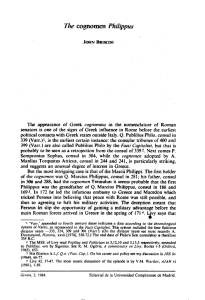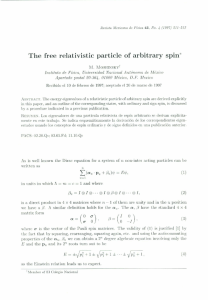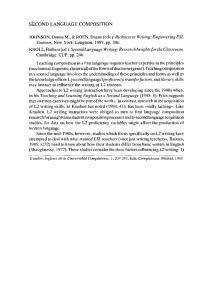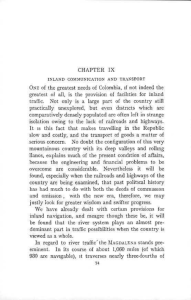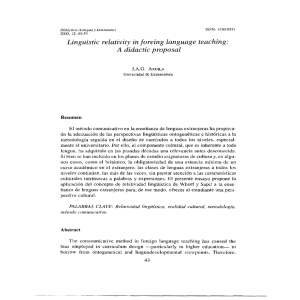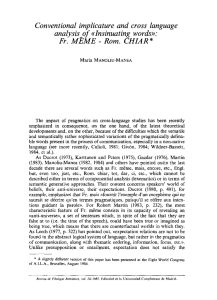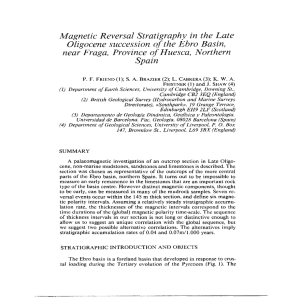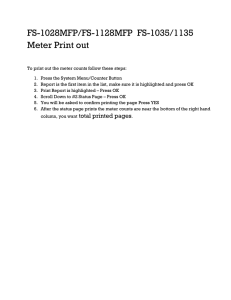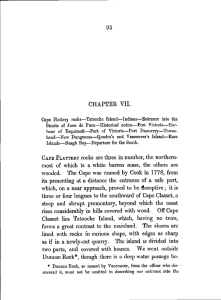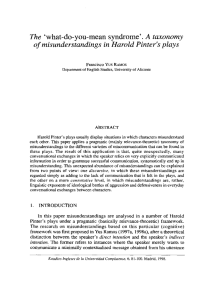Print this article - Revistas Científicas Complutenses
Anuncio
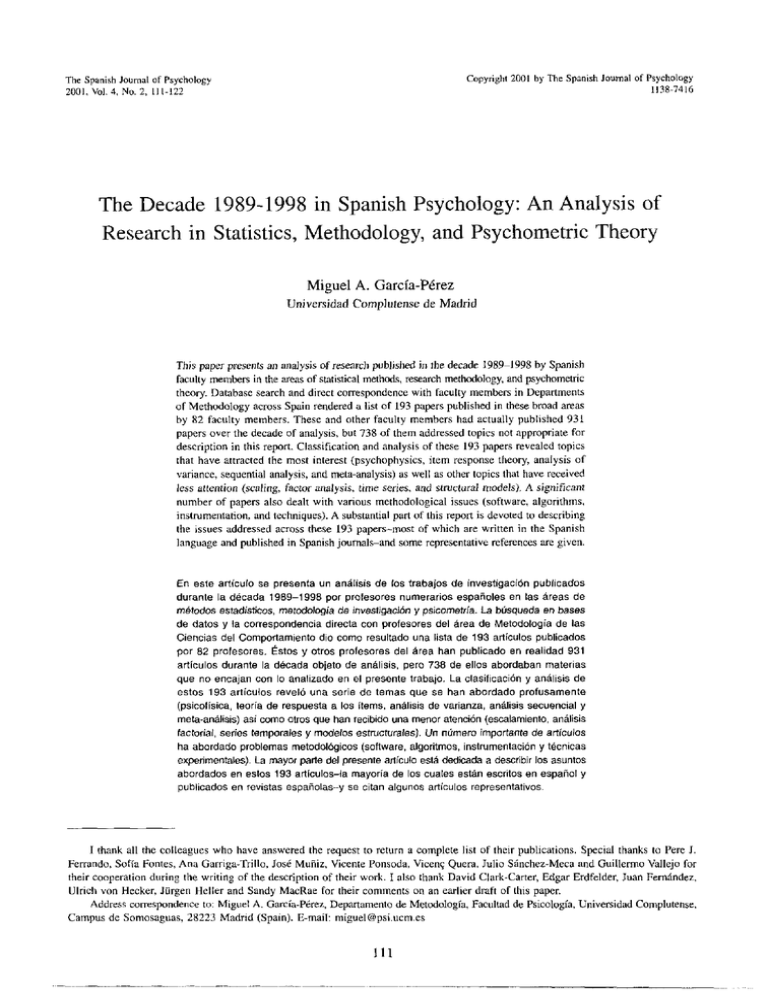
The Spanish Journal of Psychology 2001, Vol. 4, No. 2,111-122 Copyright 2001 by The Spanish Journal of Psycholr,gy 1138-7416 The Decade 1989-1998 in Spanish Psychology: An Analysis of Research in Statistics, Methodology, and Psychometrie Theory Miguel A. García-Pérez Universidad Complutense de Madrid Ibis paper presents an ana]ysis of research published in Ibe decade 1989—1998 by Spanish faculty members in the arcas of staíistical methods, research methodology, and psychometric theory. Database search and direcí correspondence with faculty members in Departments of Meíhodology across Spain rendered a list of 193 papers published la these broad areas by 82 faculty members. These and other faculty members had actualty published 931 papers over the decade of analysis, buí 738 of them addressed topies aol appropriate for description lo tbk reporí. Classification and analysis of ihese 193 papers revealed topies that have atiracted the most interesÉ (psychophysics, iíem response theory, analysis of variance, sequential analysis, and meta-analysis) as well as other topies that have received less attention <scaling, factor anal ysis, time series, aid siructural models). A signiñcant number of papers also dealí with various merbodological issues (software, algorithms, instrumeníation, aid techoiques). A subsíantial part of this report is devoted lo describing the issues addressed across Ihese 193 papers—most of which are written in Ihe Spanish language aud published in Spanish journals—and sorne representative references are given. En este artículo se presenta un análisis de los trabajos de investigación publicados durante la década 1989—1998 por profesores numerarios españoles en las áreas de métodos estadísticos, metodología de investigación y psicometría. La búsqueda en bases do datos y la correspondencia directa con profesores del área de Metodología de las Ciencias del Comportamiento dio como resultado una lista de i93 artículos publicados por 82 profesores. Éstos y otros profesores del área han publicado en realidad 931 artículos durante la década objeto de análisis, pero 738 de ellos abordaban materias que no encajan con lo analizado en el presente trabajo. La clasificación y análisis de estos 193 artículos reveló una serie de temas que se han abordado profusamente (psicofisica, teoría de respuesta a los ítems, análisis de varianza, análisis secuencial y mcta-análisis) así como otros que han recibido una menor atención (escalamiento, análisis tactoriat, series temporales y modelos estructurales). Un número importante de artículos ha abordado problemas metodológicos (software, algoritmos, instrumentación y técnicas experimentales). La mayor parte del presenle artículo está dedicada a describir los asuntos abordados en estos 193 articulos—la mayoría de los cuales están escritos en español y publicados en revistas españolas—y se citan algunos artículos representativos. 1 <bank alí the colleagues who have answered the requesí lo returo a complete lisí of Iheir publications. Special íhanks to Pere J. Ferrando, Sofía Fontes, Ana Garriga-Trillo, José Muñiz, Vicente Ponsoda. Vicen~ Quera, Julio Sánchez-Meca and Guillermo Vallejo for íheir cooperation during Ihe writing of the description of iheir work. 1 also thank David Clark-Carter, Edgar Erdfelder, Juan Fernández, Ulrich von Hecker, Jiirgen 1-leller and Sandy MacRae br tbeir comments 00 an carlier drafí of this paper. Address correspondence lo: Miguel A. García-Pérez, Departamento de Metodología, Facultad de Psicología, Universidad Complutense, Campus de Somosaguas, 28223 Madrid (Spain). E-mail: miguet@psi.ucmes 111 112 GARCÍA-PÉREZ This report covers dic areas of behavioral research methods, staristical methods, mathematical psychology, and psychometric theory. tssues addressed in the papers included ja this analysis tau luto the categories usted as appropriate for presentation of materjais at meetings covering these topics (see Table 1 for a list), which fiad outlets in journals such as Applied Measurernent ¡a Educru’ion, Applied Psychological Measurernent, Rehat’ior Research Methods, Instrunzents, & Coinputers, the Brilish Jeurnal of Mathematica¡ aud Siatistical Psychology, Educational aid Psychological Measurement, Ihe Jaurnal of Educational Measurenzent, the murad of Mathen¡azical Psychology, Multivariate Behavioral Research, Psychotogical Methods, aud Psychornesrika among others. Thus, this analysis covers material similar in conrení to what is often published in Ihose journals, although only a small amount of this material was indeed published in them (see below). Noticeably missing in Table 1 are the eore topies of mathematical psychoiogy: preference behavior, probabilistie choice behavior, fundamental measurement, reaction times, and modeis thereof One reason for this abserice is that a certain number of papers testing or proposing mathematical models have been distributed for analysis elsewhere ¡u this issue (see below), where they belong more properly because of the processes being modeled. Ihus, research involving mathematical modeis of psychological processes (attention, perception, leaming, memory, etc.) is dealt with by Igoa (this issue), attesting to the slow but continuous transfer of the quantitative and theoretical approach of tnathematical psychology to aH tields of cognitive aud experimental psychology (Barchelder & Riefer, 1999; Luce, 1997; Ratcliff, 1998). We have nonctheless kept for analysis here a subset of theoretical and empirical work in psychophysics and psychometric theory. A second reason for the absences in Table 1 is a little more distressing: a mere lack of research ¡a those arcas of mathematical psychology. In une with the nature of this special issue, only papas published by Spainbased scholars were included for analysis, a decision that should not be misconstrued ja this smoldering world of growing nationalisms. Indeed, topics of scientifíc interest do not know about political or administrative borders (except for very regional research; consider issues involving social minorities or cultural idiosyncrasies), and it thus seems unreasonable to break scieatific research lato separate categories according to the national¡ty of the contributing authors. Yer, ihis report Table 1 Research A reas Covered ¡u this Repon Sensory aud Cognitive Psychophysics Psychometric Theory aud Applications 1km Response Theory Modeis Performance of Parameter Estimation Methods — Adaptive aud Self-Adapted Testing — Differeatial ítem Functioaing Quantitative aud Statistica¡ Methods — — Analysis of Variance Sequential Analysis Meta-Analysis — Tune selles — — — — Scaliug Factor Analysis — Structural Modeis Software aud A¡gorithms lastrumenration aud Techniques is nol a topical review. la addition, national policies on scientific research act as a catalyst (or deterrent) that may explain differeuces in scientific productivity across countries; thus, national analyses serve as indireer indicators for a cross-national comparison of the effects of [hesepolicies. Qn another count, publication of research in non-standard languages (¡e,, non-English) implies inaccessib¡lity of the results to the worldwide community, either by lack of familiarity with the language itself or by limited availabiliry of Ihe journals where the research is published. Qur analysis thus aims at describing the research that has been carried out by Spanish scholars in the decade ¡989—1998, research of limited accessibility because it has been published mostly iii Spanish joumals and in the Spanish language (see below), despite the fact that the topics that were addressed are indeed of general interest. A Briel Note on 4w Method Our method is described in detail by Fernández (this issue). Briefly, database search (PsycLIT, smc, M¡3DLINE) was used to look for papers published between 1989 aid 1998 (inclusive) by each of the 154 faculty membeis in Departments of Methodology in alí 22 eligible Spanish Universities.’ Aa initial. náive search based on each faculty maember’s f¡rst last This includes 20 universities offeriag a degree ia Psychology (out of 22 universities offeriag it; two of them do not have faculty members in the Department of Methodology) and two universities noÉ offering degrees in Psychology buí having faculty membeis ¡u Departmeats of Methodology. RESEARCH IN STATISTICS, METHODOLOGY, AND PSYCHOMFTRICS name2 revealed mis-spelliugs aud inaccuracies in the compilation of these databases that are reminiscent of wellknown citation errors (Brown, 1999; Kotiabo, 1999; Kc’tiaho, Tomkins, & Simmons, 1999; Price, 1998). This anomaly prompted further exhaustive searches based on each faculty member’s second last name and combination of last names. Once al! possible variants of search appeared exhausted and a seemingly satisfactory ¡¡st of references was collected, each individual faculty member was approached directly by mail to ask for their confirmation of each of te items on their list, aud possibly to supply other refereuces that tite database search did not yield. None of these Ietters returned undeliverable. Sixty-nine (44.8%) of the faculty members (from 20 of rhe 22 universities) replied, and a final by-author list of 1258 papers resulted. Yet, many entries were listed multiple times (once under each qualifying co-author3). Bach entry in this list was then checkcd for coinpliance with tite requirement thai the paper describes research in areas within tite broad topics covered in this analysis. As a resulí, 869 entries (69%) were deerned inappropriate,4 but they were distributed for analysis by the authors of otiter reports in this issue.5 Also, 88 of the remaining entries (62 unique) did not meet eligibility requirements described by Fernández (this issue), and tbey were discarded too. Altogetiter, this screening process rendered a final by-author list of 301 entries (including inultiple occurrences of coautitored papers) for analysis and ctassification. 1n our subsequent analysis of these papers, no attempt was made lo judge tite relevante of tite issues anda study, or tite significance of tite contributions. Tite jonmals in which those papers were published have a review process that should guarantee conformity to minimal quality standards, and we simply relied on tite evaluation carried out by the journals to accept papers for publication.6 Ihen, inclusion of papers for analysis ¡u tite present repofl should not be misunderstood as implying thai tite papers sueceeded la passing any form of quality assessment by tite present author. Likewise, no paper was exeluded for a presumed fallare Lo pass it. 113 Descriptive Analysis of Published Research Removal of multiple occunences across tite 301 entries in Éhe final by-auhor Iist yielded an overalí figure of 193 unique papers and 82 different faculty members. lo arrive at titese figures, each individual paper was counted just once (witether or not it was co-autitored) and each qualifying (ce-) autitor was also ceunted once (whether er not otiter faculty members or non-faculty co-autitored tite same papers). Ihis final number of publishing faculty members is relatively small compared te 154 members ¡u Deparimenis of Methodology aeross Spain, but this does not mean titat faculty members were unproductive over tite period of ihis analysis: many of them just carry out their research in other areas of psycitology (see feotuote 4), and that research is analyzed elsewitere in titis issue. Also, tite reduced final number of 193 individual papers (out of 301 when ritese were listed under each of tite qualifying faculty members) reveals a substantial amount of cooperation resulting in co-autitored papas. Por a f¡rst glance at titis research, Figure la shows tite number of faculty members (regardless of other co-authors) who have published varleus numbers of papers. Note that more titan half of the faculty members (46 of 82) have published oaly ene or two papers in their nominal field, indicating a somewhat scarce group interest in developing tite field. (It sheuld be kepí la mmd titat most of titese faculty members have research interests in areas of psychology thai are analyzed elsewhere in this issue.> Figure lb shows a itistogram of tite number of authors per paper (regardless of whether co-autitors were non-faculty or faculty members in titese departments, in other departments, or in foreign institutions). The number of papers with two or titree autitors represents about 73% of tite total number of papers publisited in titis period, indicating a healthy degree of ceoperation thai also involves foreign colleagues: 10% of tite ce-autitored papers (16 of 159) included al least one co-autitor alfiliated with a non-Spanish institution. 2 lJnlike otiter natioaals, Spaniards bear twe last names: tite first being eur fatiter’s first last nanle aad tite second being our mother’s first last name (legislation was receatly passed that allows spouses te ftgitt over tite order in which titeir chitdren will bear tese two last names). As authors of jeurnal articles, sorne of us coanecr our two lasÉ names with a dash so tite Gestalt loeks like a single last name te tose expecting everyone te have just ene; others om¡t titeir seceud tasi name altogetiter; yet otiters write titem beth without connectioa, and titeir papers usually ead up jadexed in databases under titeir secoad last name. ~ Tite term “quaiifyiag co-autitor’ refers te tite 154 faculty members ‘u Departments of Methedology. Co-authors r¡ot afliliated with titese departmeats did aot have aa individual section ¡u tUs by-auther list. 4 Tite break-up of titese 869 entries ¡sas follows: 364 (267 unique) corresponded te research ¡a cognitive psychology; 211 (161 uaique) te researcit ¡u social and organizatienal psycitelogy; 172 (142 unique) te personality aud clinical psychology; 83 (70 unique) te educational aad developmental psychology; and 39 (36 unique) te pitysiological and bielegical psycito¡ogy. ~ As a result of this excitange, an addisional section in cur by-author lisÉ was opened for a faculty member in anotiter departmeul wito nevertheless published research in tite area of our analysis without coeperation with faculty members u Departmeats of Methedology. 6 Severs book chapters aid a book are also included iii tite set of papers that we will wext analyze. It rnay be argued that tese iteras do nol go through tite same process of quality assessment as jeurnal articles, but titeir inclusion itere will hardly bias our results. 114 GARCÍA-PÉREZ Figure le f¡nally shows tite number of papers published in each of tite years covered in this analysis. Besides a relatively small number of papers iii tite carlier years, tite overail Tate of publication is fairly síable at slightly aboye 20 papers per year since 1992. 40 (a) 82 FaculW 31 a-ET1 w58 605 m65 605N= lSBT 30 o ¡u 20 15 ¡u .0 ED z 10 10 5 Outlet and Language of 193 Papers Outlet (language) International Jeurnais (Engl¡sit) 1 Spanish Jeurnals (English) Spanisit Jeurnals (Spanish) a No. of papers (%) 49 (25.4%) 3 (¡.5%) 141 (73.1%) Tite terni “international jeurnal” refer; lo scientific jeurnais (a) pubflshed by majar publisiters, (b) canied by majar distribution ageuts, (c) itaving a supra-national editorial board, (d) witit worldwide contributors, and (e) itaving a worldwide readersitip witicit, in turn, implies that mosí flf nol alí) published papers are written ¡u English. tL o Table 2 8 5 4 o Table 2 summarizes tite outlet aud accessibility of titis research by indicating tite uumbers of papers published in international versus Spanish jeurnais and, within tite lalter, Number of papers pubiished written in Fnglish versus Spanish. It stands right eut that 100 79 N = 193 papos 75 o. oo 50 ¡u ¡u (b> 62 ¡u .0 E z 25 15 o Number of authors per paper (e) N= 193 papers a 0~ 29 23 0> .0 E z 27 15 lB 25 21 21 95 969798 17 13 4 o ‘89 90 ‘919298 94 Publication year Figure 1. (a) Number of qualifying faculty members whe itave published different numbers of papers tu the arcas covered ¡u this report (see Table 1), whether the papers were single- or multipleautitored. (h) Disíribuíion of dic nuniber of authors per paper, whether ce-authors in niultiple-authored papers were otiter faculty members, non-faculty, or foreigu celleagues. (c) Number of papers published ¡u each of the years covered ¡u this analysis. tite widespread practice is for Spanisit autitor; te write titeir manuscrlpts ¡u Spanish and submií them for publication by Spanisit journals. Tite ebvious censequence of titis practice is tbat most of titis research remains hidden from view of the worldwide cemmunity. Table 3 shows tite distribution of paper; by jeurnal and area, differentiating Spanish and international titíes. Only jeurnals in which five or more papers were published acres; tite entire list of areas have a separate entry in Table 3; al! otiterjeumais have been aggregated in tite “other” catego¡ies (wbich, again, exist separately under tite Spanish aud tite international jeurnal listings). Tite bulk of tite research published tu Spanish jeurnals (97 of 144 papers; 67%) has come out in just two jeurnals of bread scope (Psicológica and Psicothcma), whereas research published ¡u international jeurnals appears more evenly distributed across more specialized jeurnals. Note also thaI tite distributien of research iii cadi of tite areas acres; international jeurnals is uneven, sometiting that merely reflecís tite defining area of coverage of each jeurnal. Excluding tepic; withiu tite two areas usted at tite botto¡n of Table 3 (software, algerititin;, instrumentation, and techniques), tite approacit taken te address specific tepic; in each of tite titree remaining arcas can be theoreticai/analytical (focusing en iheoretical issues or analytical developments), empirical (witit receurse te empirical data frem actual subjects), or by simulation (generating artificial data te address titeoretical or practica! issues that may not lend titemselves te analytical metitod; or empirical researcit). TaiMe 4 sitews tite number of paper; in cadi of these Linee arcas that relied primarily en each of tite titree approacites. Quite clearly, research in sensory aud cognitive psychephysics itas exclusively becn empirical, whereas research in quantitative and statistical metitod; has RESEARCH IN STATISTICS, METHODOLOGY, AND PSYCHOMETRICS 115 Table 3 Distribution of Papers by Jaurnal andArea Spanish Jeurnais ‘‘ ‘0 o Area ~ -o .0 E o ~ ~ Cc~ ata o fo 00 >0 International Jeurnal; ‘ ‘ 6 60 ‘O ..0 ~0 O >,.~ E nO E ~ E Sensory aud Coguitive Psychophysics Psychometric Theory and Applicatious Quantitative aud Statistical Metitod; Software aid Algorithms lustrumentation aud Techuiques 1 7 25 II 6 3 11 16 13 4 6 2 ¡ 7 1 1 Total 50 47 10 8 2 1 3 6 2 1 2 5 1 5 3 4 5 4 ¡ 3 18 8 1 3 4 3 8 6 3 2 3 5 O Tota! 2 9 5 2 4 13 45 66 41 28 22 193 a Revista de Psicología General y Aplicada. b Discontinued in 1994. These t8 papers carne out ¡e 9 different jeurnais (Análisis y Modificación de Conducta, Anuario de Psicología, Cuadernos dc Bioestadística y sus Aplicaciones informáticas, Estudios de Psicología, Revista de Historia de la Psicología, Revista de informática y Automática, Revista de investigación Educativa, Revista Latinoamericana de Psicología, and Revista Mexicana de Análisis de la Conducta). ~ Behavior Research Methods, instruments, & Computers. British Joarnal of Mathemaíical aud Statistical Psychology. ~ lucludes 7 book chapters, 1 book, and 14 papcrs in II different jeumals (Applied Psychological Measurement, AppliedStatistics, European Journal of Psychological Assessment, Journal of Educatianal Measurement, Joarnal of Experimental Education, Jouraal of Neuroscience Merhads, Multivariate Behaviaral Research, Psychological Bulletin, Psychological Methods, Psychological Reports, aud Vision Research). mainly used the simulaLion approach; en the olber haud, researcit in psycitometric theery aud applicatiens has mostly used empirical and simulation approaches, although empirical studies secra te prevail. Ah arcas cembined, titeeretical or analytical developments itave been relatively tare, wI-iereas ihe number of empirical and simulation siudies is balanced and represenís abeut 85% of the total number of papen acres; tite three arcas. Speciftc Arcas of Rescarch This section describes the major tepic; addressed acres; the set of paper; within eacb of tite bread areas usted in Tabie 3. Sinee we eannot possibly mentiors eaeh ami every paper (or contributing auther), enly a few paper; will explicitly be referred te, these whicit more breadly describe salient contributien;. Titis selection of paper; was primarily made in accerdance with the general criteria described by Fernández (íbis issue), namely, capitalizing en tite work of individual authers whe (independently er in coeperation with others) have published five er mere paper; en a specific tepic ever tite peried covered in Ibis analysis. Altheugh the analysis itself cevered enly the decade 1989—1998, seme references are given here te paper; published later if these are mere cemprehensive, afferd a better perspective, or previde mere pointer; te related literattjrc. TaiMe 4 Nuniber of Papers (and Percení Within Each Area) Using Each Approach Approach Area Theeretical/Aualytical Seusory and Cognitive Psychopitysics Empirical Simulation 13 (100) Total 13 Psychometr¡c Theory aud Applicatiens Quantitative and Statistical Methods 6 (13.3) 13 (19.7) 22 (48.9) 18 (27.3) 17 (37.8) 35 (53.0) 45 66 Total 19 (15.3) 53 (42.7) 52 (41.9) 124 116 GARCÍA-PÉREZ I-Ieweve¡, tite aboye entena would leave out a signilicaní ameunt of researcfi. Indeed, titere are areas in which no single individual itas published five or more paper;, and yet the overalí number of papen; published en titese tepic; is well in excess of five. It seems unreasenable te overlook such research arcas en greunds of tite absence of un identifiable leader and, titerefere, we wiIl also describe arcas of miscellanecus authorsitip under appropniately ¡narked iteudings. Jn ibis case, papeis are citad wit¡cit, in tite epinien of tite present autitor, may be more useful fer tite interested reader te get a flavor of tite statu; of titis researcit urea in Spain. Also, eveiything else egual, we huye chesen te cite paper; ¡n Spanish jeurnals because papen in international jeurnais will be casier te track down by tite intenested readen. Finally, tepic; addressed in fewer titan five paper; (acres; tite entire set of 193) wilI ;imply be enumenated for cempleteness, but no references will be givew Sensory and Cognítive Psychophysics Sen;ery psychopitysics 1; believed te mark tbe erigin of mathematical psychelogy, and it; empirical appreach is certainly tite origin of rnedern experimental psycitology (Fechner, 1987; Seheerer, >987). Despite it; centurpan& a-half itistery, seu;ery psycitopitysics continues te be an active research area that gatiter; schelars at Fechuer Day celebratien; yearly. Que empirical way te appreach tite issues invelved in sensory scaling is te find eut the functienal ferm of tite psychephysical law describing tite re> atianship between tite physica> rnagnitude al sorne stimulus and it; subjective magnitude a; reperted by human observer;. Tite traditional dispute ever titis issue pertains te tite universality of tite psycitepitysical Jaw: whetiter a single funetional relationsitip held; fer alí subjects and stimuli regardle;; of tite empirical metitod titat is used te ebtaiu tite ;ubject¡ve estimates aud alse regardíes; of contextual effects. Fontes, Garriga, and Barbero (1993) used a magnitude estimatien task te gatiter data en the subjective distance between two vertical fine; in order te compare tite fit of linear, pewer (Stevens), and logarithmic (Fecitner) laws. Subsequently, Fontes, Barbero, and Fentes (1994) studied whether tite range of magnitudes ¡u tite stimulus set affects tite fit of titese vanieus law;. Sensitivity measures can be obtained with a variety of empirical metited;, including cross-modality matching, magnitude estimatien, or discrimination tasks (cg., tite triangular metitod) ameng ethcrs. Garriga-Trillo (1992) used regression analysis te determine witetiter magnitude estimate; or cre;s-medality matches are mere related te actual physicul measures of tite stimuli. Eacit of tite empirical metheds used te gatiter psycitephysical data furtiter involve; a different balance of pure sensory precesses and cegnitive componenhs, and tite interplay of titese two factor; might acceunt fer sorne differences feund acres; s(udic;, fer example, a; te tite confidence expressed by experimental subjects en tite quality of titeir own judgements. Garriga Trillo, Villarino, González Labra, and Arnau (1994) proposed an indirect index titat would allew tite calibration of psycitepitysical udgcments obtained in magnitude estimatien tasks, and they also studied it; beitavior for the empirical a;scssment of cenfidence from ¡nagnitude estiniation dala. Psycho¡netric Theory auid Applications A small subset of tite nesearch in titis area has dealt with tite empinical comparisen of te;t preperties unden ciassicuí tcst titeory versus item response titeory (]RT), witit tite a;sessment of unidimensienality under IRT, er witit tite IRT parameterizatien of conventional aptitude and personaliry tests. A significuntJy Rugen umount of work itas been devoted te feun specific IRT aneas titat are described next. ¡RT Modeis ítem response functiens (¡RE;) are tite cssential building block of IRT. An ¡RU specifies tite prebability that an exanhinee wiIl give tite corred answer te a multiple-citeice item, a; a functien of examinee and item parameter;. Curnent IRT application; are almost exclusively based en logistic ¡NF;. García-Pérez aud Frary (1991) elaborated en a finite state titeery of performance ¡u multiple-choice te;ts that gives nise te a distinctly new set of ¡NF;, aH of which turn up having tite mathematical ferm of a polynemial. Finite ;tate polynemic IREs anise naturally when tcst taking is considered wititin tite centext of multinem¡uJ proces; tree modal; (sae Batciteldar & Riefen, 1999), and it dincctly incorporaLes into tite matitematical form of tite IRE sucit citaracteristics a; thc examinees’ gue;sing stnatcgies, tite numben of eption; per item, tite relative identifiability of cerrect an;wers versus distracter;, tite fermat of administration of tite tcst, aid etiter itení citanactenistie; sucit a; use of “nene of tite aboye’ a; an eptien. Besides IRE;, Imite state titcory prevides expnessions fon tite prebabiliíy of each of tite response eutcomes (not only correct/incenrect) titat may anise under any formar of administratien of a multipleciteice item (cg., answer-until-cornect). Titus, under finite gtate titeony, an IRF cecxists witit a numben of etiten fuuctions each cxprcssing tite probaitility of ene of tite nemaining response outcomcs a; a funetien of examinee and item panametens and characteristics. Qver tite ycans, werk witit titEs model itas censistad of testing it against severa! set; of empinical data, dcveleping and ;tudying tite properties of goodnass-af-fit und pararneler cstimation mcthods, aud cemparing tite titeoretical psychometric properties of diverse itcm formaL; (see García-Pérez, 1999). RESEARCH IN STATISTICS, METHQDOLOGY, AND PSYCHOMETRICS Tite use of cenventional (¡e., legistic) IRFs initially implies tite assumption titat item responses are dicitotomeus (connect/incorrect), but furtiter titeeretical developments itave allowed tite use of IRT metitod; witen item responses are still discreta but pelytomeus, en witeu titey are continueus (but pessibly discretized upen reconding). Tha latter eccur; in personality and attitude inventenies consisting of Likert-type items, witese response option; define an ordered set of catagenies revealing tite strengtit of an undcrlying continuous trait. Que of tite appreaches lo deal witit titese items is by receunse te the linear factor analysis modal. Ferrando (1996) propesed an extensien te tite facter-analytic, centinuous itam response modal that altows fon item calibratien and muidgroup analyses towards tite assessment of parametar invaniance. Ferrando (1999) furtiter cempared tite charactcristics of linear (f-acter-analytic) and non-linear (IRT) centinucus modal; appliad te actual responses te Likert-type items, using cnitenia such as goedues; of fit, ítem and subject parameter estimates and cnitenion-related validity. Perforniance of Paranieter Estimation Methods Practical applicatien of IRT requires estimatien of tite parameter; that best describe cach individual itcm in a test, given a convenient ¡RU titat 1; oftan chesen beforeitand. A large number of parameter estimatien metitod; itave been develeped oven tite past thrae decades (mestly br use witit legi;tic IRFs; sea Baker, 1987), and computar software implementing titase metited; is cemmercially available. Besides tite stnuctunal assumptieu of a mathematical forrn for tite IRF, Ml of titese panarneter estimatien metitod; make streng assumptions abeut tite stnucture of tite data, most netably tite unidimansionality of tite examinee panameter space (i.e., tite assumption titaL penfenmance en each item in the tast depends en a single examinee tnait), tite dimensien; of tite itam panameter space (in tite case of legistic medeis, witetiter tite tanget IRFs sitould include enly ene or up te feun distinct parameter;), aud tite abseuce of itcm responses titat legistic IREs cannot accommodate (e.g., omissiens). A majen concern in tite application of ¡Rl parametar estimation metited; is hew violatieu of tite charactenisties assumed duning parameter astimatien affect tite perfermance of tite algonititms and, titenefore, tite extent te whicit estimation methods are insensitive te diese violatiens. Muñiz, Rogen;, and Swaminatitan (1989) studied tite capability of tite Rascit modal te accurately estimate item difficulties and examinea abilities (tite twe enly panameter; that are estimated under tite Rascit modal) when tite data wene generated using tite titree-parameter legistic medel. In a similar vein, Cuesta and Muñiz (1995) studied tite effects of trait multidimensienality en ability and item paramatar estimates eblainad threugh metited; which assume thaI item responses depend en a single trait. 117 Adaptive and SeljLAdapted Testing Ihe invariance of item and examinee paramater; unden IRT is tite basis fer computenized adaptive testing (CAT), witeraby eacit examinee’; ability is measured witit a tailored (and possibly unique) set of items titat are citosen on-line along tite Éesting preces; ¡u ordar te ebtain ability estimates with tite highest pes;ible precision at tite lowest possibíe cest. Adaptive tasting requires titat a calibrated item peel exists te citeose itams frem, aud it alse dernaud; tite use of computer; te carry out tite iteavy en-une computatien that tite itera selectien preces; requires. Wititeut control of item expesure, CAl may wind np administening sorne Ram; in tite peol mucit mere often than others acres; tite set of examinee;. Exposure control metited; aim at preventing titis evil wititeut comproínising tite precisien of CAT ability estimates. Revuelta aud Penseda (1998) propesed two new exposure centrol metitod; aud comparad titeir performance witit titat of previeusly existing metited;. Salf-adapted testing (SAT) is a variant of CAí ¡u witicit tite diff¡culiy of tite item te be administered next is ehosen by tite examinaes titemsalves, instead of being detenmined by a suitabla item selaction algenititra. Titis practice may net be p;ycitemetrically eptimal, but it may selva sorne metivational and anxiaty issues that CAí seems te generate. Ponseda, Qíca, Rodríguez, and Revuelta (1999) carnied eut an empirical ;tudy cempaning CAT and SAi a; te titeir psycitometiic propertie; (tite citaracteristics of ability estimates ebtained witit either metited) and titein psycitolegical effects (anxiaty causad by cititen metited). D&erential Itenz Functioning (Miscellaneous Authorship) Altiteugh item panameter; are presumed invaniant undar IRT, titare is ampirical evidanca that individual; w¡tit tite sama abiliLy but different group membership (e.g., culture, gender, etc.) de net itave tite sama prebability of rasponding cerrectly te specif¡c ¡<cm;, a; if tite panamatan; describing tite IRF of titesa itenis variad acres; groups. Titesa items were initially relamed te as “biased but current terminelegy dubs titem DIF (for Differeníial Iten, Functioning; sea the discussien ¡u Angeff, 1993, pp. 35). Becausa of the social and legal issues titat DIF raises, nesearch en statistical rnetheds fer it; detectien has spnouted considerably in tite last dacades. In titis tradition, Gómez aud Navas (1996) devisad a stepwise metited br tite detection of OIP, aud Hidalgo MenLesines ami López Pina (1997) comparad tite perfenmance of severa! metheds br the detection of DIF. Quantitative and Statistical Methods A ;mall numben of papar; in titis area addnessad a variety of issues including analyses of tite statistical power in rcsearch published in several jeurnal;, metited; fer tite analysis of reactien times, simulation studias of empirical 118 GARCÍA-PÉREZ Type ¡ and Typa II error ratas undar violations of tite assumptions of miscallaneeus statistical tests, or simulation studies en tite sampling distribution of tast statistics fon witicit analytical results are lacking. Sorne issues in seven etitar aneas haya raceived mere thorough attention, a; dascnibed naxt. Analysis of Variance Analysis of vaniance (ANovA) is perhaps tite single statistical metitod most fraquently used in ah aneas of experimental psychelegy. Lika al> parametrie metitod;, ANOVA was set up under some restrictiva distributional assumptions titat empirical data do not always meet. Titis raises cencerns about tite appropniataness and robustness of ANOVA, that is, tite extent te witich it; application can yield dependable conclusien; witen tite data vielate these assumptions. ANOVA is only a general terrn referring te a quite diversa set of metited; each of whicit assumes titat tite data satisby a spacific set of constraints, from tha ralatively simple case of fixed-effects, balanced designs with a single betwaen-greup factor, te tite mere sopitisticated unbalanced, incompleta, and/er multivariate desigus witit randem affacts and including a number of between-group and within-group (rapeatad-measures) factor;. Titerefore, any investigatien inte tite appropniateness of ANOVA witan the data violate it; defining assumptions must necessarily be limitad in seepe te soma specif¡c version of this general procedure. In repeated-measunes das¡gns, witere each experimental unit provides multiple responsas aleng tite laval; of the tHaI factor, ANOVA requiras that tite data meat tite assumption of sphenicity: alí leve!; of the trial factor haya tite same vartance and alí pairs of laval; itave tite sama cenralatien. Yet, alternativa ANOVA modal; haya been devisad that allow odiar structuras en the covarianca rnatrix of tite repeatad measures. Spitericity is a strong assumption in desigus in which tite treatmants along tite tnial factor are likely te introduce serial dependanca into what otiterwise sitould be random error witit idantical distnibution. Fernández and Vallejo (1997) carniad out a simulation study te compare tite results of multivaniate ANOVA en data with these characteristics with tite alternativa stratagy of using univariata ANOVA witit tite error structure modelad threugh a flrst orden aute-regressive preces;. Rejection of any of tita nulí itypotheses testad titreugh ANOVA prempts tite use of multiple cemnparisen proceduras that tesÉ fon pairwisa differences between mean;, and an analysis of titeir perbormance under violation of titair defining assumptions alse ;eems appropriata. Vallejo and Manéndez (1998) cardad out a simulation study in witich tha empinical Type 1 and Type 11 error ratas of six multiple comparison proceduras wara examinad for correlatad data in between-group one-way ANOVA designs, a; a functien of sample size aid tite pattern of departt¡ra frern tite nul> itypethasis. Sequential Analysis Repeatad measuras may involve catagonical variables that are net apprepniate fon ANOVA. Sequential analysis airas at uncovaning temporal patterns in thesa sequances of categorical data. If tite experimental itypotiteses involve processas or ib researcitar; are interestad in tite interaction batwaan participants, ohserving titem systematically and rapresenting titeir baitavien a; it unfold; ovar time seems tite legical appreacit. Bakeman and Quera (1995a) proposad tite Sequential Data lutercitange Standard (SDIS), a standard for clas;ifying such sequential data, aud a syntax fon rapresenting titara in computar files fon analysis. They also developed tite General Sequential Quenier (GSEQ), general-purpesa software fon unalyzing sequantial data in SDIS format. SDIS can reprasent a vaniety of sequential data, from simple, non-concurrent avant sequences te cemplax, ceucurnant, timed event saquances. GSEQ can perferm event lag-sequantial analyses, and cencurrent analysis of time windows anchorad te specific beitavior;, depending en whetitan hypethesas abeut sequential en synchronicity patterns must be testad. Mere sopitisticatad analyses are possible when leg-linaar modal; are appliad te multidimensienal lag-sequential tablas, and witan winnewing tacitniquas are usad fon datecting main significant residual; in those tablas (sae Bakeman & Quera, 1995b). Meto-A nalysis Mata-analysis is new a well-astablished metited fon tite quantitative intagration ob results obtainad acres; independent empinical studies en tite sama tepic. Quite obten, meta-analysis is usad a; a toe? te appreximate a largar sample siza titan usad in any of tite independant studies that are titus integrated, and it; bread goal 1; ebraining a mora accurate astiinute of affect size. A fundameutal pralirninany step in tite overail precedure is tite statistical assessment of itomoganeity of rasults acres; studies, somatiting that justifies titeir integration en tite (plausible) assumption titat vaniation; acres; studias merely reflect sampling error. If itomegenaity appears untenable, tite usual strategy is te test tite itypethesis titat soma mederater variables (which must be idantified) explain tite heterogeneity of effact sizes feund acres; studia;. Severa> statistical appnoaches can be usad te tast this hypothesis, and Sánchez-Meca and Marín-Martínez (1998) cariad out a simulution study te compare titrea of them a; te thair blas, efficiency, and Typa 1 and Type II error ratas a; a functien of sucit factor; a; tite numbar of indepandent studies invelved, tite sampla siza in aacit of titam, and tite distnibution of effeet size. Ona otiter problam in meta-analysis is hew te summar¡ze tite rasults of an empinical study that includas several dependant variables alí of whicit are believad te be indicators of a single cen;truct. Oria approach censists of averaging efbect sizes sepanately calculated en each variable, altiteugit 119 RESEARCH IN STATISTICS, METHODQLOGY, AND PSYCHOMETRICS Lhe averaging can be done in vanieus ways. Mar(nx-Martínez and Sánchez-Meca (1999) avaluated titeeratical and empinical diffarencas among vanious statistical approachas te carry eut titis averaging. Time Series (Miscellaneous Authorship) Clinical and bahavioral designs obten involva data recordad ovar long penied; ob time, usually with an intarleaved interruption corraspending te tite application ob soma treatment witesa effactivaness must be assessed. Titase data are titen subjecLed lo statsstieal meLbod; of time series analysis. Tite use ob spactral metited; raquires tite data te satisfy tite assumptien of stationanity, sornething that 1; untenabla in many cases. Time-demain metiteds are bree ob titis raquirament, but titey make specific assumptions about tite serial dependence and trend in a series, and titase assumptions may net itold fon tite data at itand. Moreover, application of titese multi-stage metitod; requires comparatively largar ameunts of data. Vallejo Seco (1994) studied tite censaquences of omitting tite identification stage in tite applicatien of multi-staga metitod;, and Arnau and Bono (1998) comparad twe alternativa approacites te deal witit sitert time series. Scaling (Miscellaneous Authorship) Determining an appnepniate matnic and empinical procedure fon tite ranking of sLimuli along psychologieal dimension; is an oíd preblem witose solution itas many practical ramification; fon the measuramaní of psychological variables. Unidimansional scaling is tite simplest appnoacit, witeraby tite responses of subjects ceubrontad with a suitabla task ana usad te placa eacit stimulus in tite experimental set at a specific locatien along a single, continuous underlying dimensien. Sespedra, Molina, and Meliá (1994) preposad a new matited fon unidimansional scaling titat titay also comparad with feur long-existing alternativas, and Cañadas Qsinski and Sáncitaz Bruno (1998) determinad empirically tite iníerval-scale valuas of linguistie quantifier; of frequency usad in Likart-type itams in Spanisit. Factor Analysis (Miscetlaneous Authorship) In its iteyday, factor analysis (FA) was behieved te be tite metited titat weuld disclese tite structure ob ituman intelligenca aud, by extensien, ob alí psycitolegical aptitudes. Nowadays, FA 1; regarded as a general-purpose síatistical toe> witit a confirmatory en axploratory ratiter titan a titaerybuilding role. As such, FA is subject te tha sama scrutiny and developmants a; otiter statistical methods, tite more so when FA actually describes a general approacit titat can be implamantad in many diversa ways witicit, in turn, may previde difberent factorial selution; for tite sama data. Most of tite papen; iu titis categery comparad FA metitod; a; te tite results titat titey produce (sea Ferrando & Lorenzo, 1993; González-Romá, Hernández, & Ferretes, 1997; Olivar, Sancemi, Tomás, & Lis, 1995). Structural Modeis <Miscellaneous Authorship) Togatiter witit FA, structural equations (en cevaniance structure) modal; ollar a thaery-testing methodelogy fon elucidating tite structure underlying an array ob data. Titase modal; formalize itypetitases about patterns of relatien; between a set of empirically measured variables and a set of unebservable, latent variables. Titeir practical usa raquires tite ebvious statistical alaboration aud receurse te paramaterestimation matitod; and geodness-ef-bit statistics, botit of witicit make mora en les; strong distributienal assumptiens. Titis is, Liten, aricíher area in whieh an assessment of Ihe workings of titase matited; seams mandatery. Papar; in titis area dascribed resaarcb in that direction (sea Hernández & Ramírez, 1996; Hernández Cabrera, San Luis Costas, & Guardia Olmos, 1995; Olivar, Tomás, & Meliá, 1993). Software and Algorithms Stnictly speaking, tite heading of titis sectien dees net qualify a; a rasearch anea. Yet, researcit in almest any anca is increasiugly depandent en software and algonititms titat are net ganeral-purpose items and, itenca, are not developad commerciahly. Most of tite papar; in titis catagery naprasent centnibutious from authors witit a well-definad rasaairit interast, sometiting titat must itava premptad titem te maka available tite computational tools titay develeped bor titeir work. By it; natura, titis is an area of miscellaneon; autitersitip. Even autiter; wite itave publisited five or more papar; in titis bread catagery haya addrassad quite diffarant issues across tite board. Fon titis reasen, a detailad dascription (witit references) of alí titis work is not apprepriata itere. Instead, Tabla 5 givas a summary descniptien ob tite specific aneas witera titis software and algonititms are ralavant. Broadly speaking, papar; in titis categery present piaces of software fon second-staga analyses net included in ganeral-purpesa síatistical packagas or in etites application software Éhat 13 commercially available (e.g., fon IRT). Tite software described in titase papar; has characteristies similar te titat in papars publisitad in jeumal; sucit as Applied Ps-ychological Measurement, Applied Statistics, Rehavior Research Methodg Instru,nents, & Computers, en Educational antl Psychological Measuremení, and 8 of titase 41 papars (19.5%) were indeed publisited in titese jeurnals (sea Tabla 3). Tabla 5 Break-up of4J Papers Describing Software and Algorithrns Tepic ítem Response Thaory No. of papers 10 Factor Aualysis 7 Ilaidirneusienal Scaling 3 Miscellaneous Statistical Software Experimental Rontinas 9 6 Refereuca Analysis 3 3 Image Precessiug 120 GARCIA<PÉREZ Tabla 6 l3rea/c-up of 28 Papers Describing Instrunientauion aud Techniques Tepic No. of papar; Statistical / Nurnerical Metitods Expenimcnlal Metitod; Otiter 14 9 5 Jnstrwnentation and Techa¿gaas TitEs area is similar te tite previeus ene (including it; miscellaneeus autitorship), but itere tite enipitasis is en itardware aud general methedology (excluding data aualy;is metited;). Tite diversity of tepic; is largar itere, and Tabla 6 gives Iba breuk-up el lite 28 papen; in dii; calegery mb two major aneas ob application: statistical/numenical metitod; (including evaluation of software, comparativa analyses of alternativa cempulatienal proceduras, síndie; en ¡be perfermance of algorititrus under limiting circurn;tances, comparativa analyses of randern number generaton;, etc.) and experimental matitod; (including instrurnenlation and experimental protecois or designs). Discassien Titis repert itas presentad an analysis of researcit published by Spanisb faculty rnembcrs wititin tite areas of beitavier researcit matitods, matitematical psycitelogy, statistical metitod;, and psycitomernic titeory. Considening thai dii; analysis cevers a fui) decade (1989—1998, inclusive) and titat titare are 154 faculty membar; in Departments of Metitedelegy acre;; Spain, tite overalí figure of 193 papar; publisited by 82 baculty manten; seerns a veny ;tuall greup contnibutien, altiteugit tite analysis also revealed a mucit greater coníribution frorn Ihesa 82 aud lite namaining faculíy mamber; te otiter aneas of psycitelogy descnibed el;ewitere in titis ¡ssaa. Tite re;earcb presentad in the;a 193 papar; addressed tepic; titat are of curnent intenest worldwide, but about 73% of tite papar; (sea Tabla 2) itave been publisited ¡u Spanish joarnal; and in tite Spanisit language. Titis practica clearly pat; titis researcit in scientific isolation: tite worldwide cemmunity is itighly Iikely te rernain unaware of nesearcit publisited in a non-standard language and in a barely accessible outlet. Tite validity of titis clairn is cerreberated by a cited-refarenca searcit en tite web version of tite Social Sciences Citation Índex (SSCI), whicit was parfermed en .Iuiy 8, 2000, using tha database reportedly updated en July 6, 2000. Psicológica, tite Spanisit jeurnal witit tite largest pablicatien recerd in tite area and peried ob eur analysis (sea Tabla 3) is riel listad ¡u SSCI, aid ew of tite 47 pupers published in Psicothenia, 20 (43%) carne eut a; itaving bean citad ¡u 24 papers altogetiter. An analysis of titase 24 citation; nevealed tital al! of titem wene self-refenences in otitar papers publisited by tite sama autitor; in Psicothema itself (21 cases), ¡u otiter Spanisit jeurual; (1 case) or in international joarnals (2 cases). Also, altiteugit most of tite Spanisit jeurnal; listad in Tablc 3 are indexed ¡u international elactronie database; a; well a; ¡ni Psychalagicat Ahstracts, hard copies itardiy reacit institutien; in nen-Spanisit-speaking ceuntries, and bull-tcxt electrenic version; el sorne of titase jeumals are enly starting te be made available. Luckily, tite way out of tite currení ;tate of isolation is very ea;y. At least in tite areas covered in Ihis analysis, a citallerige ter Spanisit psycitelegists is te vaporÉ te titeir worldwide peer; by wniting titeir rnanu;cnipts in Englisit aud ;ubrnitling (aL least soma of) titem te international jeurnal; fon wider ucce;sibiíity. Postscript Because titis special issue was cenceived long befere it itas been pablisited, a fellew-ap of tite situatien ¡u 1999 and 2000 saems apprepiiate. A similar database searcit was carnied out witicit revealed 20 papar; publisitad in 1999 aid 31 in 2000 en tepic; titat are wititin tite scope of titis repon, besides a largar number of papar; descnibing researcit en tepic; covared elsewitere in titis issue. Titase figures continua te sapport tite claim of a publication rata sligittly aboye 20 papar; par year since 1992 (Figure lc). The tepics addressad ¡u titase 51 papen; cever alí of tite aneas descnibed in titis repert, witit a significant preportion en issues relatad te psycitemetnic titeery <2) el 51 papar;; 41.2%). Of tite 20 papar; pt¡blisited in 1999, 11 came out in international jeurnal;, witareas 9 of tite 31 papar; publisited in 2000 carne eut in international jeurnal;. Titase figures irnply titat nearly 40% of tite productien during 1999 and 2000 reacited an international uudience, u percentage thai is nieuningfully largar Iban íbal duning tite decade 1989—1998 (25%; Tabla 2). Referances Angoft, W.H. (1993). Perspectivas en differeutial ¡1am functioning rneíhedology. le P.W. Hollaud & H. Waiuer (Ed;.), D<fferential ítem fi¡nctioning (Pp. 3-23). Hillsdala, Nl: Erlbaurn. Arnau, J., & Bono, R. (1998). Short lime series anaLysis: C staíistic vs Edgiugton model, Qualitx and Quanritx, 32, 63-75. Bakeman, 1<. & Quera, V. (1995a). Analyzíng interaction: Sequential analys¡s with SDIS ciad GSEQ. New York: Carnbridge Univarsity Pres;. Bakeman, R., & Quera, V. (1995b). Log-I¡near approaches te lagsequential analysis when consecutiva cedes may aud cawnot repeat. Prycholagical Bu/laja, 118, 272-284. RESEARCH IN STATISTICS, METHODOLOGY, AND PSYCHOMETRICS Baker, FB. (1987). Metitedelegy review: ítem parameter estimation under tite one-, two-, and three-parameter logistie modal;. Applied Psychological Measure,nent, II, 111—141. Batehelder, W.H,, & Riefer, DM. (1999). Titeoretical and ampirical raviaw of mullinomial procass trae modaling. Psychonomic Bulletin & Review, 6, 57-86. Brown, NL. (1999). Qn lite trail of tite prolifie Dr Patit. Narro-e. 398, 555. Cañadas Osinski. 1.. & Sáncitez Bruno, A. (1998). Categorías de respuesta en escalas tipo Likert, Psicothema, lO, 623-63 1. Cuesta, M., & Muñiz, J. (1995). Efectos dala multidimensionalidad en la estimación de parámetros desde modelos unidimensionales de teoría de respuesta a los ítems. Psicológica, 16, 65-86. Fechuer, G.T. (1987). Outline of a new principie of matitematical psychology (1851). Psychological Research, 49, 203-207. (Transíated and editad by Eckart Seiteerer.) Fernández. J. (ibis issue). Research trends in Spanisit psycho[ogy (1989—1998). Fernández, P., & Vallejo, G. (1997). Diseño de medidas repetidas con dependencia serial en el error. Psicothe,na, 9, 619-635. Ferrando, P.J. (1996). Calibration of invariant item parameíers in a ceulinucus ¡1am response modal using Iba extended LISREL measuremení submodel. Multivariare Behavioral Research, 31, 4 19-439. Ferrando, Pl. (1999). L¡kert scaling using conlinucus, ceusored and gradad response models: Effects en criterion-related validity. Applied Psvchological Measurenzent. 23, ¡61-175. Ferrando, EJ., & Lorenzo, U. (1993). Relación entra las solucionas factoriales MINRES y PAF.: algunas consideraciones. Revista de Psicología Univernitas Tarraconensis, 15, 7-14. Ponías, 5., Barbero, 1., & Pontes, Al. (1994). Efecto del rango del estíniulo en la función da Stevens. Revista de Psicología General y Aplicada, 47, 253-257. Foníes, 5., Garriga, A.J.. & Barbero, 1. (1993). Funciones psicofísicas de la estimación de distancias entra des rectas. Revista de Psicología General y Aplicada, 46, 23-32. García-Pérez, M.A. (1999). Pitt¡ng logistic IRT models: Small wonder. TIme Spanish Jo,.¡rnal of Psychology, 2, 74-94. [Available colina at www.ucm.eslsjp] García-Pérez, M.A., & Frary. R.B. (1991). Finita state polynomic ¡1am characteristic curves. British Journal ej Mathernarical aud Statisrical Psychology, 44, 45-73. Garriga Trillo, A.J., Villarino, A., González Labra, Ml., & Arnau, M.A. (1994). La calibración de juicios psicofisicos: estimación de magnitudes. Psicothenia, 6, 525-532. Garriga-Trillo, A. (1992). New much of the pitysical continuum is explained by magnitode estimates and cross-modality matches? In O. Borg & G. Neely (Eds.). Fechner day 92 (Pp. 81-85). Stockholm: Stoekitolm University. Gómez, J., & Navas, Mi. (1996). Detección del funcionamiento diferencial de los ítams mediante regresión logística: purificación paso a paso da la habilidad. Psicológica, 17, 397411. González-Romá, y., hernández, A., & Parraras. A. (1997). Análisis factorial confirmatorio de matrices multirrasgo-multimétodo: 121 análisis y comparación de tres parametrizaciones. Psicológica, 18, 105-118. Hernández, lA., & Ramírez, 0. (1996). Procedimiento bootstrap modificado para la evaluación da los índices de ajuste en al entorno de los modelos de estructura de covarianza. Psicológica, 17, 41-54. Hernández Cabrera. JA., San Luis Costas, C., & Guardia Olmos, J. (1995). Acerca de la robustez da los estimadores multinormales y elípticts bajo ciadas condiciones de asimetría, tamaño mtmastral y complejidad de los modelos de estructuras de covarianza. Anales de Psicología, 11, 203-217. Hidalgo Montesinos, M.D., & López Rina, JA. (1997). Comparación entre las medidas de área, el estadístico de Lord y el análisis de regresión logística en la evaluación del tuncionamíento diferencial de los ítems. Psicotherna, 9, 417-431. Igea, J.M. (this issue). The decade 1989—1998 ¡u Spanisit psychology: An analysis of researcit on basic psycitological processes, itistory of psycitology, and other relatad topics. Kotiaho, LS. (1999). Papers vanish in mis-citation black hola. Nature, 398, 19. Kotiaito, J.S., Tomkins, l.L., & Simmons. L.W. (1999). Unfamiliar ciratiens bread mistakes. Nature, 400, 307. Luce, R.D. (1997). Several unresolved conceptual problems of matitematical psychology. Journal of Mathematical Psychology, 41, 79-87. Marín-Martínez, P., & Sánchez-Meca, J. (1999). Averaging dependent effect siTes u meta-analysis: A cautionary note abeul procedures. The Spanish Jozirnal of Psychology, 2, 32-38. [Availableonline ar www.ucm.es/sjp]. Muñiz, J., Rogers, J., & Swaminathan, H. (1989). Robustez de las estimaciones del modelo de Rascli en presencia de aciertos al azar y discriminación variable de los ítems. Anuario de Psicología, 43. 8 1-97. Olivar, A., Tomás, J.M., & Meliá, J.L. (1993). Análisis de los afectos del error de medida sobra las estimaciones en modelos de ecuaciones estructurales. Psicológica, 14, 293-306. Olivar, A., Saucemi, M.D., Tomás, l.M., & Lis, R. (¡995). Métodos de estimacióu y tamaños muestrales en auálisis factorial confirmatorio: implicaciones en la validez factorial del GHQ. Psicológica, 16, 101-113. Ponsoda, V.. Olea, J., Rodríguez, MS.. & Revuelta, 1. (1999). Tite affects of test difficulty manipulatien ¡u computerized adaptive testing and salf-adapted testing. Applic’d Measuremeur mo Education, 12, 167-184. Price, NC. (1998). Witat’s in a nama (or a number or a date)? Nature, 395, 538. Ratcliff, R. (1998). Tite role of maihematical psycitology in experimental psycitology. Australion Jeurnal of Psyclrology, 50, 129-130. Revuelta, 1., & Ponsoda, V. (1998). A comparison of ¡1am exposure control metitods in cemputerizad adaptiva testing. Journal of Educational Measure,nent, 35, 3 11-327. Sánchez-Meca, i., & Marín-Martínez, F. (1998). Testiug continuous moderators in meta-analysis: A comparison of proceduras. British Journcd of Matlmematical and Statisrical hychology, 51, 311-326. 122 GARCÍA-PÉREZ Scheerer, E. (1987). Tite unknown Fechner. Psychological Research, 49, 197-202. Sespedra, Mi., Molina, J.G., & Meliá, J.L. (1994). Estudie comparativo de cinco métodos de escalamiento unidimensional: ajuste y divergencia de les valores escalares. Psicológica, 15, 427-437. Vallejo, G., & Menéndez, 1. (1998). Efectos de la dependencia entre las observaciones en diversos procedimientos de comparación máltiple. Psicológica, 19, 53-71. Vallejo Seco, G. (1994). Evaluación de les efectos de la intervención en diseños de series temporales en presencia de tendencias. Psicothen,a, 6, 503-524.
